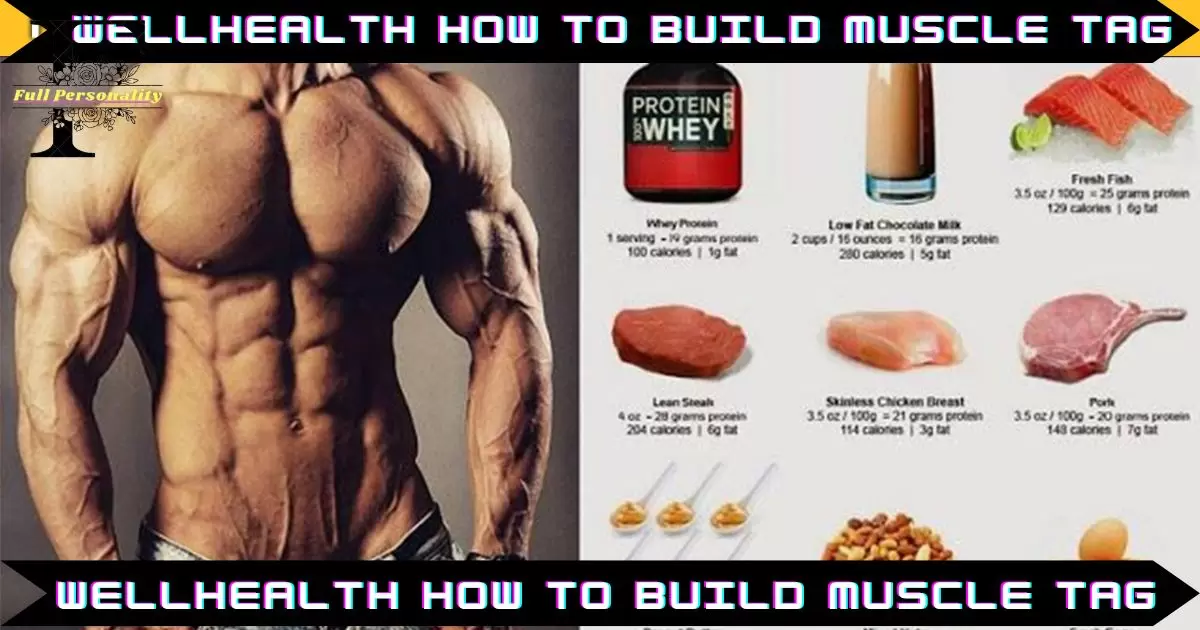Introduction to Building Muscle
Building muscle isn’t just about lifting weights; it’s a journey that requires dedication, strategy, and knowledge. Whether you’re a seasoned gym-goer or just starting, understanding how to build muscle effectively can transform your fitness experience. The right approach can lead to not only stronger muscles but also enhanced overall health and well-being.
In today’s fast-paced world, finding trustworthy information is crucial. That’s where the concept of “health, how to build muscle tag” comes into play. This guide will explore essential strategies for building muscle in a way that’s sustainable and effective. From resistance training techniques to the importance of nutrition and recovery, we’ll cover everything you need for success on this transformative path.
Let’s explore these five essential strategies for achieving your muscle-building goals while promoting better overall health!
wellhealth how to build muscle tag

Building muscle requires a multifaceted approach, and understanding the core components is essential. The “wellhealth how to build muscle tag” serves as a guide, emphasizing the importance of developing a personalized strategy.
Nutrition plays an indispensable role in this journey. Protein-rich foods, such as lean meats, legumes, and dairy products, fuel muscles for growth and repair.
Resistance training should be at the forefront of any muscle-building plan. It creates micro-tears in your muscles that heal more robustly than before. Compound movements like squats and deadlifts are particularly effective.
Cardio shouldn’t take a backseat either; it enhances overall fitness levels while improving recovery times between workouts. A balanced routine includes both weightlifting and cardiovascular exercises to optimize results.
Don’t forget about rest days; they allow your body to recuperate fully after intense sessions. Proper sleep contributes significantly to muscle growth by aiding hormone production and recovery.
The Role of Resistance Training
Resistance training is a cornerstone of muscle building. It involves using weights, resistance bands, or even body weight to challenge your muscles. This exercise stimulates muscle fibers, leading to growth and increased strength.
Tiny tears occur in the muscle tissue when you lift weights or perform resistance exercises. Your body works diligently to repair these tears, making the muscles more robust and prominent.
It’s essential not just to focus on heavy lifting; varying your routines can yield better results. Incorporating different movements targets various muscle groups and keeps workouts fresh.
Remember that proper form is crucial for safety and effectiveness. Prioritize technique over sheer weight to maximize gains while minimizing injury risk.
Integrating resistance training into your weekly routine can drastically improve physical performance, metabolism, and overall health. Embrace it as an integral part of your journey toward building muscle effectively.
Incorporating Cardio into Your Routine
Cardiovascular exercise is often viewed as separate from muscle-building, but it plays a crucial role in an effective fitness routine. By incorporating cardio, you enhance your overall endurance and promote heart health.
Aim for moderate-intensity activities like jogging or cycling a few times a week. This will elevate your heart rate without sacrificing strength gains.
Consider interval training as well. Short bursts of high-intensity effort followed by recovery periods can stimulate muscle growth while reviving your metabolism.
Keep in mind that balance is essential. Too much cardio can hinder muscle development if not carefully managed, so find what works best for your body and goals.
Integrating these exercises into your weekly plan fosters better performance during resistance workouts and aids in faster recovery post-training sessions. Your body thrives on variety; mixing things up keeps workouts exciting!
Rest and Recovery: The Forgotten Element

Rest and recovery often take a backseat in the hustle of muscle-building. Many people underestimate their importance. Yet, they are crucial for progress.
When you lift weights, tiny tears occur in your muscle fibers. It’s during rest that these fibers repair and grow stronger. Without adequate downtime, growth stalls.
Sleep plays an essential role, too. Quality sleep helps regulate hormones like testosterone and human growth hormone, both vital for muscle development. Aim for 7 to 9 hours each night.
Active recovery can also be beneficial. Light activities like walking or yoga promote blood flow without overstressing your muscles.
Listening to your body is critical. If you’re tired or sore, don’t push through it unthinkingly—permit yourself to rest. Balancing hard work with proper recovery sets the foundation for long-lasting results and overall health benefits in your fitness journey.
Staying Consistent and Setting Realistic Goals
Consistency is the backbone of muscle building. It’s not about hitting the gym occasionally; it’s about making it part of your lifestyle.
Setting realistic goals keeps you motivated. Aim for small, achievable milestones instead of chasing an unrealistic dream overnight. Celebrate every little victory along the way—whether it’s lifting heavier weights or completing an extra set.
Track your progress meticulously. Documenting your workouts can reveal patterns and help you adjust as needed. This habit encourages accountability, pushing you to stick with your routine.
Remember that setbacks are normal. Life gets busy, and there will be days when motivation wanes. Acknowledge these moments, but don’t let them derail your journey.
Incorporate flexibility into your plan, too. It’s okay to modify workouts if they aren’t working or you feel tired one day.
Prioritize sustainability over intensity; this mindset fosters long-term success in building muscle.
Conclusion: Achieving a Strong and Healthy Body
Building muscle is a journey that requires dedication and effort. Embracing various strategies allows you to create a solid foundation for success.
Focusing on nutrition will fuel your progress. A balanced diet rich in protein supports muscle repair and growth. Please don’t underestimate the power of hydration; it plays a significant role in recovery.
Resistance training is the cornerstone of your routine. Incorporating diverse exercises keeps workouts engaging while effectively targeting different muscle groups.
Cardio shouldn’t be neglected, either. It enhances cardiovascular health and aids recovery, working harmoniously with strength training.
Rest periods are paramount for optimal results. Allowing time for muscles to heal prevents burnout and promotes steady gains.
Staying consistent and setting achievable goals is vital. Celebrate small victories to stay motivated on this ongoing path toward building a robust and healthy body.
Introduction to Building Muscle

Building muscle is more than just lifting weights. It’s a transformative journey that enhances strength, endurance, and overall health. Many people embark on this path to improve their appearance or athletic performance.
Muscle development involves resistance training, proper nutrition, and adequate rest. Each element plays a crucial role in achieving your goals. Understanding how these components work together can set you up for success.
When starting, it’s essential to focus on form and technique over heavy lifting. This approach helps prevent injuries while laying the groundwork for future gains.
Moreover, patience is essential; muscle growth takes time and dedication. Embracing this process will foster physical and mental resilience as you become more robust with each workout session.
Understanding the Importance of Nutrition for Muscle Growth
Nutrition plays a vital role in muscle growth. Without the proper fuel, your body can’t effectively build and repair those muscles you work hard to enhance.
Protein is often the star nutrient. It provides the building blocks for muscle tissue and helps to repair damage sustained during workouts. Aim for protein sources, such as lean meats, dairy products, legumes, and nuts.
Carbohydrates are equally important; they are your body’s primary energy source. Consuming complex carbs like whole grains and vegetables will give you sustained energy levels throughout your training sessions.
Don’t overlook healthy fats, either. They support hormonal balance and overall health, achieved through resistance training.
Hydration should not be forgotten. Staying well-hydrated aids digestion, enhance performance during workouts, and keeps recovery on track.
The Role of Resistance Training in Building Muscle
Resistance training is the cornerstone of muscle building. It involves working against a force, typically weights or resistance bands, to challenge your muscles. This exercise causes tiny tears in muscle fibers, prompting them to repair and grow stronger.
Engaging in various forms of resistance training can effectively target different muscle groups. Free weights facilitate flexibility and functional strength, while machines offer stability for beginners.
Progressive overload is vital; gradually increasing weight or intensity ensures continuous growth. Aim for compound movements like squats and deadlifts that recruit multiple muscles simultaneously.
Consistency matters, too—regular sessions lead to significant gains over time. Mixing up your routine keeps it fresh and prevents plateaus.
Listening to your body during these workouts is crucial; proper form reduces injury risk while maximizing results.
Incorporating Cardiovascular Exercise into Your Routine
Cardiovascular exercise plays a vital role in any fitness regime, even when focusing on building muscle. Activities like running, cycling, or swimming can enhance your overall performance and endurance.
These exercises boost your heart rate and improve circulation. This increase in blood flow helps deliver essential nutrients to your muscles, promoting growth and recovery.
Aim for at least 150 minutes of moderate-intensity cardio per week. You don’t have to go all out every session; balancing lifting weights and cardiovascular workouts is critical.
Consider interval training as an option. Short bursts of high-intensity effort followed by rest periods can be particularly effective for burning fat without compromising muscle gains.
Listen to your body, adjust the intensity, and remember that this variety adds excitement to your routine while supporting those hard-earned muscles.
Rest and Recovery: The Often Overlooked Aspect of Building Muscle
Rest and recovery are crucial yet often neglected parts of muscle building. Many enthusiasts focus solely on lifting weights, overlooking the importance of giving their bodies time to heal and grow stronger.
Muscles don’t develop during workouts; they recover and adapt afterward. This process requires adequate rest periods between intense training sessions. Without them, you risk injury and hinder progress.
Quality sleep is also vital for muscle repair. During deep sleep, your body releases growth hormones that facilitate tissue regeneration. Strive for 7-9 hours per night to support your goals.
Incorporating active recovery days can enhance blood flow without straining muscles too much. Light activities like walking or yoga can aid in this process while keeping you engaged.
Prioritizing this aspect will improve performance and lead to sustainable gains over time. A well-rounded approach ensures long-lasting strength development.
wellhealth how to build muscle tag

When building muscle, understanding the “wellhealth how to build muscle tag” can set you on the right path. This approach emphasizes a holistic view of fitness that integrates various elements crucial for growth.
First, focus on your training regimen. Resistance exercises are foundational in stimulating muscle fibers. Compound movements like squats and deadlifts should be central to your workouts.
Next up is nutrition. Fueling your body with adequate protein and healthy carbs supports recovery and enhances strength gains.
Remember cardio; it’s essential for heart health and aids in maintaining a balanced physique while elevating performance in resistance training.
Prioritize rest days—your muscles need time to repair and strengthen after intense workouts. Balancing these components will help optimize your journey toward muscle-building success.
Conclusion: Consistency is Key in Achieving Your Muscle-Building Goals
Building muscle is a journey that requires dedication and the right approach. Consistency plays a critical role in achieving your desired results. Stick to your resistance training regimen, ensure you’re incorporating cardio wisely, and remember to prioritize rest and recovery.
Set realistic goals to keep yourself motivated as you progress. Celebrate small victories; they add up over time and will encourage you to stay on track.
Stay committed, listen to your body, adjust your strategies when necessary, and embrace the growth process. With patience and perseverance, you’ll succeed in building muscle while enjoying an active lifestyle.



